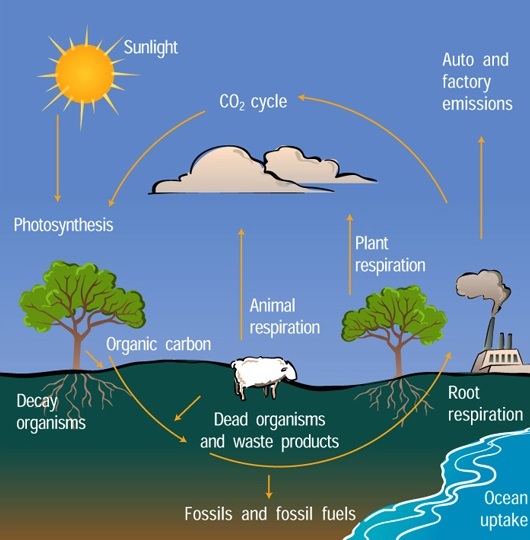9th Grade > Biology
NATURAL RESOURCES MCQs
:
A, B, and D
The given image depicts carbon cycle.
Photosynthesis is a biological process used by plants to prepare food with the help of sunlight, water and carbon dioxide.
Burning of fossil fuel (combustion) and respiration release carbon dioxide into the atmosphere. Hence, these processes are involved in carbon cycle.
Transpiration is the process by which water vapour is lost from the aerial parts of a plant. It is a part of the water cycle.
:
A
Ozone layer is present in the lower parts of the stratosphere. It absorbs all the ultraviolet radiations and does not allow them to reach Earth's surface, thus protecting all living organisms from the harmful effects of UV radiations.
:
A and C
Lichens grow on the surface of rocks. They release certain substances that cause the rock surface to powder down and form a thin layer of soil. They also enrich the soil by trapping water, dust and silt.
:
A, B, C, and D
The air that covers the whole of the Earth like a blanket, is called the atmosphere. Atmosphere is essential for life because of the following reasons:
i) It acts as a blanket and keeps the average temperature of the Earth.
ii) It contains all the gases which are essential for sustaining life on the Earth.
iii) Ozone layer present in the atmosphere prevents harmful UV rays from reaching the Earth.
iv) Water cycle is not possible without atmosphere.
:
A, B, and D
Hydrosphere of the Earth includes water that is on its surface, underground, and in the air. It also means water in all the states - ice, liquid and vapour. Hydrosphere includes oceans, glaciers, rivers, lakes, ponds, atmospheric moisture and underground water.
:
A, B, C, and D
The wind is formed when the air moves from one region to another region. In coastal regions, when the land heats up during day time, it creates a low pressure region above the land. As the temperature over a region increases, the pressure decreases in that region. Therefore, air above the sea moves towards the direction of low pressure region. The wind moves from high pressure to low pressure region.
The other factors which effect the direction of wind are the rotation of the earth and the presence of mountain regions in the direction of wind. Hills and mountain ranges will act as a barrier, holding back the wind and deflecting it to other directions.
:
D
Plants cannot use the atmospheric nitrogen directly. Nitrogen fixation is a biological process and the initial stage of nitrogen cycle which converts atmospheric nitrogen into ammonia. This ammonia is converted into nitrite and then into nitrate by the process of nitrification. Nitrate is the form of nitrogen which is directly absorbed and used by the plants for making amino acids and proteins.
:
A
Gases and air molecules have a natural tendency to move from a region of high pressure to a region of low pressure and attain a uniform pressure throughout. When air above a region is heated, it starts rising up. As the air rises up, a low pressure region is created over that region. This will result in bulk movement of molecules of air from high pressure area to low pressure area which give rise to wind.
:
D
∙ Greenhouse gases are gases that have the ability to trap heat energy. Gases like carbon dioxide, methane, ozone, etc., are examples of greenhouse gases that lead to a rise in the Earth's temperature. Increased concentration of these gases are responsible for global warming.
∙ Oxygen, on the other hand, is not a greenhouse gas.
:
A
When water bodies are heated during the daytime, a large amount of water evaporates and goes into the air. This is called evaporation. The hot air rises up carrying water vapour along with it. As the air rises, it expands and cools. This phenomenon is called condensation. The condensation of water vapour results in the formation of clouds. These clouds are carried away with the help of wind and when they become heavy they fall down in the form of rain.

















